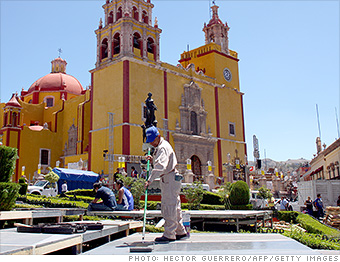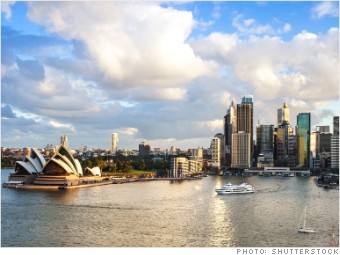Tuesday, July 30, 2013
Mini-apartments are the next big thing in U.S. cities
Could you live in a single-car garage? That's about the size of tiny apartments popping up in major U.S. cities where many residents live alone. Inhabitants say the key is keeping only stuff you use.
NEW
YORK — When Gil Blattner hired a housekeeper for his elegant apartment
with 12-foot ceilings, tall windows and marble fireplace mantle, the
woman looked at the living room and asked, "Where's the rest of it?"
There was no more. She'd seen all 250 square feet of his cocoon, located on a tony, tree-lined street in Chelsea near restaurants, art galleries and bookstores. His monthly rent: $2,500.
"It's all that I need," says Blattner, 29, who moved in last year. "I feel very happy when I'm in this space," he says."The name of the game is being selective about what you hold onto. It's helped me stay away from being a hoarder."
Though tiny has long been typical in Manhattan, mini-apartments are popping up in more U.S. cities where land is finite, downtowns have regained cachet and rents have risen. In a digital age when library-sized book collections can be kept on a hand-held device, more Americans see downsizing as not only feasible but also economical and eco-friendly.
How small? Many anti-McMansions — also known as "aPodments," "micro-lofts," "metro suites" or "sleeping rooms" — are about 300 square feet, which is slightly larger than a single-car garage and one-eighth the size of the average new U.S. single-family home (also shrinking in recent years).
City officials often welcome this mini-sizing, which is common in Tokyo and many European capitals, as a smart-growth, lower-priced solution to a housing phenom: people living alone. Nationwide, the share of households occupied by a single person reached 27% in 2010, up from 8% in 1940 and 18% in 1970. The number exceeds 40% in Atlanta, Cincinnati, Denver, Pittsburgh, Seattle, St. Louis and Washington, according to Census data.
In Seattle, which has led the nation with hundreds of dorm-like "sleeping rooms" as minuscule as 150 square feet, a backlash has taken hold. Boardinghouse-style buildings have replaced single-family homes in residential neighborhoods, prompting complaints by neighbors about parking problems, transiency and fire-safety hazards. Officials have responded by drafting building rules they'll publish this summer.
"It's an accelerating trend in the industry, especially where space is at a premium," says Ryan Severino, senior economist at New York-based research firm Reis. "You're seeing an urban renaissance," he says, adding Millennials (typically younger than 30) are drawn to cities where they can both work and socialize.
They'll sacrifice space for '"quality" location, says Doug Bibby, chief executive of the National Multi-Housing Council, a trade group, noting apartments overall are getting smaller. He says young city dwellers manage with less room by renting rather than buying stuff. "They rent everything," he says — Zipcars, even wedding dresses.
Mini-sizing "is not a fad," says John Infranca, assistant law professor at Suffolk University in Boston who's studied projects in New York, Washington, Denver, Austin and Seattle. He expects demand for tiny apartments will continue as more people, young and old, live alone. Yet he says building codes — often requiring larger units — were set decades ago when households were bigger and haven't kept pace with "radical" demographic shifts.
Boston, Chicago and other U.S. cities are experimenting with change:
•In the Big Apple, billionaire Mayor Michael Bloomberg — who once lived in a studio for nearly a decade — launched a micro-housing pilot project of 55 units that range from 250 to 370 square feet. The city usually requires apartments be at least 400 square feet.
•San Francisco, where new studio apartments rent for at least $2,400 monthly, recently approved a trial run of 375 micro-units as small as 220 square feet. In September, Berkeley-based developer Patrick Kennedy plans to begin building 120 units, each about 270 square feet, with rents starting at $1,800.
•In Austin, where rents are soaring as the population booms, the city's first affordable downtown housing project in more than 45 years breaks ground this week. It will be a complex of 135 studios, each 400 square feet. "We have Texas-sized micro-housing," says Walter Moreau of Foundation Committees, a non-profit group shepherding the project.
Developers say they can't build micro-housing fast enough.
"We don't do any advertising, and we're 100% occupied all the time," says Jim Potter, manager of Seattle-based Footprint Investments. He's finished six buildings, each with 40 to 60 units, in Seattle and is developing similar projects this year in Portland, Ore., Oakland and Jersey City.
"It's really about price point," he says, noting his Seattle units with a bed and bathroom but no private kitchen rent for $600 to $900 monthly (including utilities and Wi-Fi) while regular, larger studios start at $1,200.
"There's a substantial waiting list," says Evan Granoff, who has redeveloped the historic 1828 Arcade building in Providence to include 48 micro-lofts as small as 225 square feet. He says the units, which will open this summer, are modeled after efficient boat interiors and include built-ins such as a futon that converts into a table for four. "It doesn't feel cramped at all," he says.
HOW DO MINI-DWELLERS DO IT?
In Manhattan, where many itsy-bitsy apartments were either built before the current size requirements or illegally subdivided, residents speak with a bit of bravado about their space-saving savvy.
"We don't necessarily look at them as mini-apartments, but as standard, live-in-New York apartments," says real estate agent Jason Saft.
"I lived in about 250 square feet for five years. You really learn how to make it work," he says, recalling how he once held a dinner party for 10 and even cooked all the food in his tiny kitchen.
Changing the ceiling height or flooring materials in different areas can make a studio feel larger, says Donald Albrecht,curator of the Museum of the City of New York. The museum's "Making Room" exhibit features a full-size, 325-square-foot studio with tricked-out furniture such as an ottoman containing four nesting chairs, a fold-out dining table tucked under the kitchen counter and a TV that slides away to reveal a bar beneath.
"What's important about New York is what's outside your door," says architect Eric Bunge, who shared a 350-square-foot unit with his wife for five years. He says they spent a lot of time in their East Village neighborhood and, when friends came over, moved seats around to accommodate them.
Bunge, co-partner at the Brooklyn-based nArchitects firm, won Mayor Bloomberg's adAPT NYC design competition for the city's micro-housing experiment, which is directed at low- and middle-income residents. His units have built-in storage, 10-foot ceilings and 8-foot windows that open onto a Juliet balcony.
"The whole building is your home," says Mimi Hoang, Bunge's co-partner, citing communal areas such as dens, rooftop terrace, fitness room and bike storage. She says the project, which will be built as prefabricated modules, aims to break ground before Bloomberg leaves office in January 2014.
Severino, who has a 3,300-square foot house in New Jersey, says he and his wife had a "good experience" living in a 450-square-foot Manhattan apartment for three years when they were younger. Yet he adds, "It was nice to move back to the suburbs. I have to admit, I like my space."
'NOT FOR EVERYONE'
So do a lot of people.
Though environmentalists say density can reduce pollution per person, some Seattle residents oppose micro-housing as "density on steroids." They say the lilliputian units cause crowding in already congested neighborhoods and the month-to-month leases don't encourage people to put down roots.
Also, opponents say developers circumvent a design review process that entails community input. No such review is needed for projects with a limited number of units, and Seattle allows each unit to house up to eight unrelated people if it has a communal kitchen and living quarters for each.
"It's a severe bending of the rules," says retired resident Bill Bradburd, adding one residential lot can house 64 residents without any parking spaces.
Seattle planning official Bryan Stevens says the city, which has permitted 28 such projects since 2008 and has 17 more under review, has responded by drafting rules that would require a public design review for each building.
Potter, the Seattle developer, says his micro-product provides an affordable option without government subsidy.
"It's not for everyone," he says. "This is intended for people who are busy and want a place to sleep and take a shower." He says the units attract a mix of people, but the average age is mid-30s.
Joe Rose, 27, a college student, loves his 190-square-foot space that — in his words — is "smaller than a hotel room" and rents for $880 a month. He shares a balcony with a neighbor, cooks in the communal kitchen and, for the first time in his adult life, gave up his car for public transit.
"My father is a buy-everything-gadget guy. I'm the opposite," he says. "I'm very minimalist."
http://www.usatoday.com/story/news/nation/2013/07/30/tiny-apartments-apodments-catch-on-us-cities/2580179/
There was no more. She'd seen all 250 square feet of his cocoon, located on a tony, tree-lined street in Chelsea near restaurants, art galleries and bookstores. His monthly rent: $2,500.
"It's all that I need," says Blattner, 29, who moved in last year. "I feel very happy when I'm in this space," he says."The name of the game is being selective about what you hold onto. It's helped me stay away from being a hoarder."
Though tiny has long been typical in Manhattan, mini-apartments are popping up in more U.S. cities where land is finite, downtowns have regained cachet and rents have risen. In a digital age when library-sized book collections can be kept on a hand-held device, more Americans see downsizing as not only feasible but also economical and eco-friendly.
How small? Many anti-McMansions — also known as "aPodments," "micro-lofts," "metro suites" or "sleeping rooms" — are about 300 square feet, which is slightly larger than a single-car garage and one-eighth the size of the average new U.S. single-family home (also shrinking in recent years).
City officials often welcome this mini-sizing, which is common in Tokyo and many European capitals, as a smart-growth, lower-priced solution to a housing phenom: people living alone. Nationwide, the share of households occupied by a single person reached 27% in 2010, up from 8% in 1940 and 18% in 1970. The number exceeds 40% in Atlanta, Cincinnati, Denver, Pittsburgh, Seattle, St. Louis and Washington, according to Census data.
In Seattle, which has led the nation with hundreds of dorm-like "sleeping rooms" as minuscule as 150 square feet, a backlash has taken hold. Boardinghouse-style buildings have replaced single-family homes in residential neighborhoods, prompting complaints by neighbors about parking problems, transiency and fire-safety hazards. Officials have responded by drafting building rules they'll publish this summer.
"It's an accelerating trend in the industry, especially where space is at a premium," says Ryan Severino, senior economist at New York-based research firm Reis. "You're seeing an urban renaissance," he says, adding Millennials (typically younger than 30) are drawn to cities where they can both work and socialize.
They'll sacrifice space for '"quality" location, says Doug Bibby, chief executive of the National Multi-Housing Council, a trade group, noting apartments overall are getting smaller. He says young city dwellers manage with less room by renting rather than buying stuff. "They rent everything," he says — Zipcars, even wedding dresses.
Mini-sizing "is not a fad," says John Infranca, assistant law professor at Suffolk University in Boston who's studied projects in New York, Washington, Denver, Austin and Seattle. He expects demand for tiny apartments will continue as more people, young and old, live alone. Yet he says building codes — often requiring larger units — were set decades ago when households were bigger and haven't kept pace with "radical" demographic shifts.
Boston, Chicago and other U.S. cities are experimenting with change:
•In the Big Apple, billionaire Mayor Michael Bloomberg — who once lived in a studio for nearly a decade — launched a micro-housing pilot project of 55 units that range from 250 to 370 square feet. The city usually requires apartments be at least 400 square feet.
•San Francisco, where new studio apartments rent for at least $2,400 monthly, recently approved a trial run of 375 micro-units as small as 220 square feet. In September, Berkeley-based developer Patrick Kennedy plans to begin building 120 units, each about 270 square feet, with rents starting at $1,800.
•In Austin, where rents are soaring as the population booms, the city's first affordable downtown housing project in more than 45 years breaks ground this week. It will be a complex of 135 studios, each 400 square feet. "We have Texas-sized micro-housing," says Walter Moreau of Foundation Committees, a non-profit group shepherding the project.
Developers say they can't build micro-housing fast enough.
"We don't do any advertising, and we're 100% occupied all the time," says Jim Potter, manager of Seattle-based Footprint Investments. He's finished six buildings, each with 40 to 60 units, in Seattle and is developing similar projects this year in Portland, Ore., Oakland and Jersey City.
"It's really about price point," he says, noting his Seattle units with a bed and bathroom but no private kitchen rent for $600 to $900 monthly (including utilities and Wi-Fi) while regular, larger studios start at $1,200.
"There's a substantial waiting list," says Evan Granoff, who has redeveloped the historic 1828 Arcade building in Providence to include 48 micro-lofts as small as 225 square feet. He says the units, which will open this summer, are modeled after efficient boat interiors and include built-ins such as a futon that converts into a table for four. "It doesn't feel cramped at all," he says.
HOW DO MINI-DWELLERS DO IT?
In Manhattan, where many itsy-bitsy apartments were either built before the current size requirements or illegally subdivided, residents speak with a bit of bravado about their space-saving savvy.
"We don't necessarily look at them as mini-apartments, but as standard, live-in-New York apartments," says real estate agent Jason Saft.
"I lived in about 250 square feet for five years. You really learn how to make it work," he says, recalling how he once held a dinner party for 10 and even cooked all the food in his tiny kitchen.
Changing the ceiling height or flooring materials in different areas can make a studio feel larger, says Donald Albrecht,curator of the Museum of the City of New York. The museum's "Making Room" exhibit features a full-size, 325-square-foot studio with tricked-out furniture such as an ottoman containing four nesting chairs, a fold-out dining table tucked under the kitchen counter and a TV that slides away to reveal a bar beneath.
"What's important about New York is what's outside your door," says architect Eric Bunge, who shared a 350-square-foot unit with his wife for five years. He says they spent a lot of time in their East Village neighborhood and, when friends came over, moved seats around to accommodate them.
Bunge, co-partner at the Brooklyn-based nArchitects firm, won Mayor Bloomberg's adAPT NYC design competition for the city's micro-housing experiment, which is directed at low- and middle-income residents. His units have built-in storage, 10-foot ceilings and 8-foot windows that open onto a Juliet balcony.
"The whole building is your home," says Mimi Hoang, Bunge's co-partner, citing communal areas such as dens, rooftop terrace, fitness room and bike storage. She says the project, which will be built as prefabricated modules, aims to break ground before Bloomberg leaves office in January 2014.
Severino, who has a 3,300-square foot house in New Jersey, says he and his wife had a "good experience" living in a 450-square-foot Manhattan apartment for three years when they were younger. Yet he adds, "It was nice to move back to the suburbs. I have to admit, I like my space."
'NOT FOR EVERYONE'
So do a lot of people.
Though environmentalists say density can reduce pollution per person, some Seattle residents oppose micro-housing as "density on steroids." They say the lilliputian units cause crowding in already congested neighborhoods and the month-to-month leases don't encourage people to put down roots.
Also, opponents say developers circumvent a design review process that entails community input. No such review is needed for projects with a limited number of units, and Seattle allows each unit to house up to eight unrelated people if it has a communal kitchen and living quarters for each.
"It's a severe bending of the rules," says retired resident Bill Bradburd, adding one residential lot can house 64 residents without any parking spaces.
Seattle planning official Bryan Stevens says the city, which has permitted 28 such projects since 2008 and has 17 more under review, has responded by drafting rules that would require a public design review for each building.
Potter, the Seattle developer, says his micro-product provides an affordable option without government subsidy.
"It's not for everyone," he says. "This is intended for people who are busy and want a place to sleep and take a shower." He says the units attract a mix of people, but the average age is mid-30s.
Joe Rose, 27, a college student, loves his 190-square-foot space that — in his words — is "smaller than a hotel room" and rents for $880 a month. He shares a balcony with a neighbor, cooks in the communal kitchen and, for the first time in his adult life, gave up his car for public transit.
"My father is a buy-everything-gadget guy. I'm the opposite," he says. "I'm very minimalist."
http://www.usatoday.com/story/news/nation/2013/07/30/tiny-apartments-apodments-catch-on-us-cities/2580179/






 At the beginning of July, Mexico City Mayor Miguel Angel Mancera kicked off the city's newest marketing campaign, "Live It to Believe It."
The campaign was developed and promoted by the Mexico Tourism Board, in
which Mexico City plays a leading role, being one of the three key
destinations to spearhead the effort.
At the beginning of July, Mexico City Mayor Miguel Angel Mancera kicked off the city's newest marketing campaign, "Live It to Believe It."
The campaign was developed and promoted by the Mexico Tourism Board, in
which Mexico City plays a leading role, being one of the three key
destinations to spearhead the effort.











 The
latest travel warning for Mexico, issued by the U.S. State Department
on July 12, contained no essential changes or surprises from the last
warning that was issued on Nov. 20, 2012.
The
latest travel warning for Mexico, issued by the U.S. State Department
on July 12, contained no essential changes or surprises from the last
warning that was issued on Nov. 20, 2012.
